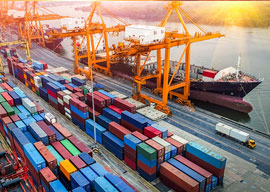Philippines Import Trade Data is an effective tool that contains crucial and essential information about the trade activities of foreign countries across the globe.
The marketing intelligence that Exim provides allows you to monitor the overall trading activities of various global countries in the global trade markets.
Philippines custom trade data is consists of several essential and vital details related to Philippines trade data including all the statistics and strategies such as HS Code, Date, Products Description, Origin of the Country, Destination Country, Mode of Transportation, Port Name & Details, Shipment & Consignment Details, importer & Exporter Name, Address of Exporter & Importer, Rates, Weight, Quantity, Volume, Unit, Total Value USD, etc.
The custom import-export data Exim Trade Data provides helps trading partners evaluate potential buyers and suppliers based on their trading history and shipping records.
Traders and merchants use Philippines import-export data to make business plans, expand their business in the overseas markets, and use it as a database for conducting market analysis.
Philippines Total Import-Exports Value Year-wise
➢ In 2019, Philippines imports totaled $152.46 billion, an increase of 4.78% from 2018.
➢ In 2020, Philippines imports totaled $119.24 billion, a decline of 21.79% from 2019.
➢ In 2019, Philippines exports totaled $106.95 billion, an increase of 2.06% from 2018.
➢ In 2020, Philippines exports totaled $91.05 billion, a decline of 14.87% from 2019.
Philippines trade statistics show the total import-export value of this country in recent years and provide useful insights into the global trade market to help you form a more effective trade strategy for your import-export trade business in the overseas market.
What are the Major Ports of the Philippines
Based on market research data and analysis reports, Calamba, Dumaguete, Cadiz, Taguilon/Ozams, Cebu, Pasig/Manila, Cagayan De Oro, Mati, Isabel, Polloc, General Santos/Dadia, Rosario, Bacolod, Manila, and Cative are some of the major ports of the Philippines as per the Philippines import port list.
What are the major exports of the Philippines?
Market analysis reports of the Philippines suggest Electrical Machinery & Equipment $31.7 billion, Electronics & Computers $9.5 billion, Edible Fruits & Nuts $2.3 billion, Technical, Optical & Medical Apparatus $1.8 billion, Copper $1.7 billion, Ash, Slag & Ores $1.7 billion, Vehicles $939.1 million, Precious Metals & Gems $1.4 billion, Plastics & Articles of Plastics $895.4 million, Animal/Vegetable Oils & Fats $918.8 million were the top exported products of Philippines according to Philippines Export Data 2020.
To ensure that the data we provide is 100% genuine, authentic, and reliable we source data from various authorized sources of links such as Authorized Customs Departments, Logistics & Shipping Companies, Trade Associations, Port Authorities, Government Bodies, and some other authoritative links.
The global import-export trade data help companies and businesses use their resources more efficiently and effectively.
The custom import-export trade data that Exim Trade Data provides allows you to monitor the trade activities of your potential business competitors in the foreign trade market which gives you the opportunity to discover new and active buyers and suppliers as well as prepare a more effective trade strategy for your global import-export trade business.
For more info on any global country, you can visit our official website and ask for free sample data or even book a free demo to get the overall overview of your trade business.







